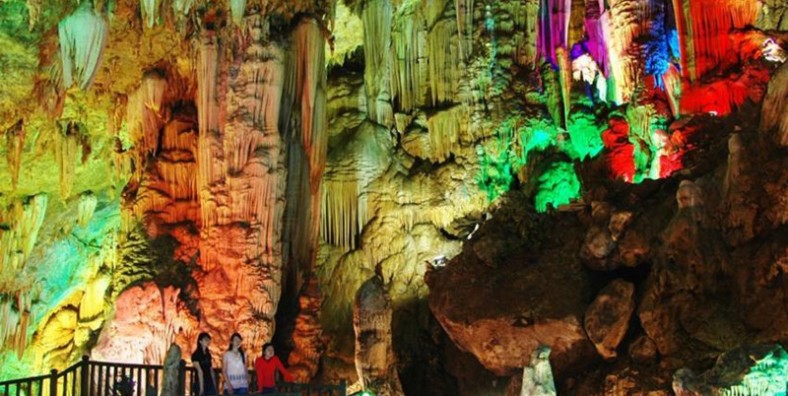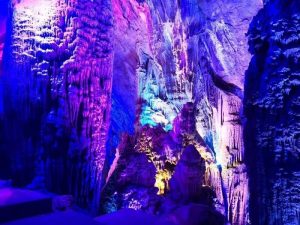Sanxian Cave in Mangshi City, Dehong

Attractions Overview
Sanxian Cave is located in Sanjiaoyan Village, Mengga Town, Mangshi, 41 km southeast of Mangshi. It has a natural cave on the cliff of the Hillside. The cave is named after three rocks resembling foxes. The cave is divided into upper and lower floors. The road is winding and the landscape is unique. The interior is 30 meters high and spans 50 meters. There are 16 halls. There are stalagmites, stalactites, stone pillars, sheets, stone flowers and other landscapes in the cave.
Chinese Name: 芒市三仙洞(Pinyin: Mangshi Sanxiandong)
English Name: Sanxian Cave in Mangshi City, Dehong
Attraction Type: Cave
Seasons: All year round
Recommended Visiting Time: 2 hours
Opening Hours: 9:30-18:00
Admission Fee: 30 RMB/Person
Address: Sanjiaoyan Village, Mengga Town, Mangshi(芒市勐嘎镇三角岩村)
Why is Sanxian Cave So Special
Sanxian Cave is located in Sanjiaoyan Village, Mengga Town, Mangshi, 41 km southeast of Mangshi. It has a natural cave on the cliff of the Hillside. The cave is named after three rocks resembling foxes. The cave is divided into upper and lower floors. The road is winding and the landscape is unique. The interior is 30 meters high and spans 50 meters. There are 16 halls. There are stalagmites, stalactites, stone pillars, sheets, stone flowers and other landscapes in the cave, which look like the icy trees and flowers, animal shapes in different poses and with different expressions and beautiful scenery.There are pavilions in front of the cave, and there are corridors with beautiful scenery, which is a good place to enjoy pleasure for people.
Where is Sanxian Cave-Location
It is located in Sanjiaoyan Village, Mengga Town, Mangshi, 41 km southeast of Mangshi.
How to Get Sanxian Cave
It is more than 40 kilometers from Luxi Passenger Station, which goes through Fengping, Fapa, Mengga. It can also be from the Dagang to Sanjiaoyan, which is about 34 kilometers. It is convenient to get to Sanxian Cave by taxi or self-driving.
History of Sanxian Cave
Sanxian Cave is located in the southern part of Mangshi, 41 kilometers away from Mangshi. It was first developed in the 28th year of Qing Daoguang. According to the historical record “Longling Record” contains: “The cave has a stone three Buddhas, which are naturally generated, not carved. The local call it as Sanxian Cave. It is said that there are goddess in the moon, a fox and a monkey, these three celestial beings in the cave. They often made their presence to bless the villagers. Later, the temple was built in the cave to enshrine and worship a buddhism goddess Guanyin, known as “Sanxiandong Guanyin Temple”, referred to as “Sanxian Temple. “With the wonders of the caves, Sanxian Cave once became the famous spot of “the tourists are moving and the incense is endless”. However, in the long river of history change, “Fairyland” has been ignorant for several times. Now Sanxian Cave is once again displayed in the world.

Best Time to Go
It is suitable to visit Sanxian Cave at any time. Every season has its own unique beauty.
Nearby Attractions
Menghuan Silver Pagoda
The Menghuan Silver Pagoda, known as the Menghuan Qianfo Silver Pagoda, is located on the hilltop opposite the Grand Silver Pagoda and a contemporary new-built Pagoda.The Pagoda is an important building of the Dehong Branch of Yunnan Buddhist College.
Menghuan Golden Pagoda
Menghuan Grand Golden Pagoda is located at Leiyarang Mountain in the southeast of Luxi (Mangshi), the capital city of Dehong Prefecture. It’s the best place to bird-eye view the town of Mangshi and those picturesque Dai villages around. Being 73 meters high, the pagoda is a three-storied octagonal but hollow one. The ground floor is the most impressive. With an area of 2,000 square meters, it’s spacious enough for nearly 2,000 pilgrims to pray at the same time. Enshrined in the hall are mainly Buddhist figures such as Sakyamuni in the east, Guanyin (Goddess of Mercy) in the south, Medicine Buddha in the west, and Maitreya (the Future Buddha) in the north, etc. all of which are made from Myanmar white marble to present grandeur and magnificence.
Mengba Naxi Rare Park
Mengba Naxi Rare Park is at the national AAAA state-level. “Mengba Naxi” in Dai language means “a magical, beautiful and fertile place,” which is just the legendary “heaven.” Situated in Xianchi Road in Mangshi City, the park covers an area of 618 mu, and was built in 2001. It is an ecological park that boasts rare ancient trees, plants and rocks. There are poems to praise it saying that “Ancient trees and rare flowers are planted in the park. There is no parallel with such beautiful scenery, and for such beauty, there is no need to visit a fairyland.” Another poem says that “the universe is full of myths. Stones in the park show its understanding of the nature, and the extraordinary workmanship of nature creates miracles.”














